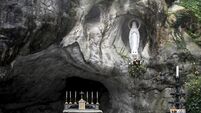St Gobnait - a mouthful of a name, but let's not write her off

The statue of Saint Gobnait / Naomh Gobnait by Séamus Murphy in Baile Mhúirne
The name, which means strength or exalted one, was the 26th most popular name for a girl in Ireland in 1965. In 2020-2021, there were fewer than three Brigids registered.
It’s harsh-sounding, a little bit hick perhaps, and it can often mutate into ‘Biddy’ which, to me at any rate, is suggestive of a busy-body and a gossip-monger. Apologies to any Biddys reading this. But we all have particular prejudices associated with strong sounding names.
St Gobnait’s feast day is February 11. One of the main centres of devotion to her is Ballyvourney, Co Cork. Her church and convent was in the Muskerry area, although she’s not pure Cork, having been born in Co Clare in the fifth or sixth century.
Gobnait is a pretty brutal name, don’t you think? (Strangely, the English equivalent is Abigail or Deborah.)
When journalist and author Fintan O’Toole, was a young lad at Irish college in Coolea, he recalls being at Mass in the little church there. In his personal history of Ireland since 1958, entitled We Don’t Know Ourselves, he writes that the church, “pebble-dashed, with no steeple,” was “more like a hall than a chapel. Someone said the church was called St Gobnait’s and I sniggered at this with a boy from my class in Crumlin. It was such a stupid redneck name. You just had to say it to know that there was something backward about these country people – gub, nit.”
This is obviously the voice of Fintan as a callow young fellow who wouldn’t now write off people as ‘rednecks’ based on their names.
But let’s not write off this medieval Irish saint. She fled a family feud, escaping to Inisheer in the Aran Islands. Here, an angel appeared to her and told her that this was not the place of her resurrection.
Gobnait was instructed that, when she came upon nine white deer, that would be her place. When she found the nine white deer in Ballyvourney, she remained there and founded a convent. The remains of the convent are still the main area of pilgrimage.
Gobnait dedicated her life to helping the sick. She is credited with saving the people of Ballyvourney from the plague.
Her life’s work included beekeeping and it has been suggested that she used honey as a medicine. One story tells of how she drove off a robber by sending a swarm of bees after him, making him return the cattle he had stolen.
In UCC’s Honan Chapel, there is a stained glass window by the Irish artist, Harry Clarke, with St Gobnait depicted on it. She is shown in profile, wearing a royal blue robe, a silver cloak and a veil. Because she is known as the patron saint of bees, she is portrayed with bees hovering around her face, with a honeycomb at her feet.
The pilgrimage round starts at the statue with pilgrims (who include a friend drawn to this much mythologised sharp-beaked nun) making a request to St Gobnait with the following prayer: ‘May God bless you, O Holy Gobnait,/May Mary bless you and I bless you too,/To you I come complaining of my situation,/And asking you, for God’s sake, to grant me a cure.’
Gobnait may be a name that will never, ever, make the list of most popular girls’ names. But the strange moniker means ‘brings joy’.
Perhaps we should pray to St Gobnait to bring us more joy in the shape of yet another Bank Holiday? She could be deemed the patron saint of ecology, given her respect for bees.
In Celtic lore, bees were always held in high esteem. There was a belief that the soul left the body as a bee or a butterfly. No doubt, the tradition of opening a window just after someone dies is to release the soul, in the guise of an insect.
Originally, Gobnait was a patron of ironworkers. Excavation at the church in Ballyvourney revealed evidence of ironworking on the site.
But I prefer to think of her communing with bees, vital for the ecosystem, but on the wane.
Perhaps we could have a St Gobnait’s Day in the summer, making it a car-free day, with a spot of gardening recommended or a walk in the countryside? You could try praying for it!







 App?
App?




